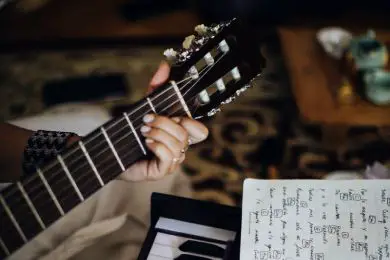Romantic chord progressions are an essential element in creating heartfelt and emotionally evocative music.
Whether you are a composer, songwriter, or a musician looking to add a touch of romance to your music, understanding and utilizing these progressions can greatly enhance the emotional impact of your compositions.
- I – IV – V – vi
- I – IV – vi – V
- ii – V – I
- ii – I – V
- vi – IV – I – V
- vi – IV – V – I
- I – vi – IV – V
- I – vi – V – IV
In this article, we will explore some popular and beautiful romantic chord progressions that you can incorporate into your own musical creations.
Understanding Chord Progressions
A chord progression is a series of chords played in a sequence that defines the harmonic structure of a piece of music. Each chord in a progression has a specific relationship to the others, creating a sense of tension and release.
Chord progressions serve as the backbone of a musical composition, providing a framework for melody and harmony to come together. They create movement and direction within a song, guiding the listener through various emotional states.
Understanding the theory behind chord progressions allows you to make intentional choices in your music, effectively conveying the desired emotions.
The Power of Romantic Chord Progressions
Romantic chord progressions have a unique ability to evoke strong emotions and create a sense of longing, passion, and intimacy. These progressions often feature rich, lush harmonies and unexpected chord changes that captivate the listener’s attention.
By incorporating these progressions into your music, you can create a romantic ambiance that resonates deeply with your audience.
The emotional impact of romantic chord progressions lies in their ability to create tension and resolution.
They take the listener on a musical journey, building anticipation and releasing it at just the right moments. The delicate balance between consonance and dissonance in these progressions adds depth and complexity to the music, heightening its emotional impact.
Common Romantic Chord Progressions
I – IV – V – vi
The I – IV – V – vi progression is one of the most widely used chord progressions in romantic music. This progression is based on the major scale and provides a solid foundation for creating emotional melodies.
In the key of C major, this progression would consist of the chords C, F, G, and Am. Experiment with different inversions and voicings to add your unique touch to this timeless progression.
Some key points to consider when using the I – IV – V – vi progression in your compositions:
- This progression has a natural flow and is often associated with a sense of nostalgia and yearning.
- The use of major and minor chords in this progression creates a delicate balance between happiness and melancholy.
- Try incorporating arpeggios or melodic embellishments to enhance the emotional impact of this progression.
ii – V – I
The ii – V – I progression is another popular choice in romantic music. This progression creates a sense of resolution and is often used to end a phrase or a musical section.
In the key of C major, this progression would include the chords Dm, G, and C. The ii – V – I progression can be embellished with additional chords and variations to add complexity and depth to your compositions.
Consider the following when incorporating the ii – V – I progression into your music:
- This progression has a strong sense of resolution and can create a feeling of closure.
- Experiment with different voicings and substitutions to add color and interest to this progression.
- Use dynamics and rhythmic variations to enhance the emotional impact of the resolution.
vi – IV – I – V
The vi – IV – I – V progression is commonly found in many romantic ballads and love songs. This progression creates a dreamy and nostalgic atmosphere, making it perfect for expressing heartfelt emotions.
In the key of C major, this progression would include the chords Am, F, C, and G. Experiment with different rhythmic patterns and chord voicings to add your personal touch to this enchanting progression.
Here are some considerations when using the vi – IV – I – V progression:
- This progression has a gentle and soothing quality that can evoke a sense of longing and tenderness.
- Explore different strumming patterns and picking techniques to enhance the romantic atmosphere.
- Experiment with modulation to related keys to add variety and interest to this progression.
I – vi – IV – V
The I – vi – IV – V progression is a versatile and widely used chord progression in various genres, including romantic music. This progression has a natural flow and can be used to create both uplifting and melancholic moods. In the key of C major, this progression would consist of the chords C, Am, F, and G. Explore different arpeggios, strumming patterns, and dynamics to infuse your music with a romantic essence.
Consider the following when incorporating the I – vi – IV – V progression into your compositions:
- This progression allows for a wide range of emotional expression, from joy and excitement to introspection and longing.
- Experiment with different chord voicings and inversions to create unique textures and harmonies.
- Use dynamic contrasts and rhythmic variations to highlight the emotional shifts within this progression.
Tips for Creating Romantic Chord Progressions
Now that you are familiar with some common romantic chord progressions, here are a few tips to help you create your own unique progressions:
- Experiment with different chord voicings: Try playing the same chord progressions in different positions on the guitar or using different inversions on the piano. This can create a fresh and unique sound.
- Explore modulation: Modulation is the process of changing the key of a piece of music. Experiment with modulating to related keys to add variety and interest to your chord progressions.
- Add passing chords: Incorporate passing chords between your main chords to create a sense of movement and tension. This can add complexity and depth to your progressions.
- Combine major and minor chords: Mixing major and minor chords in your progressions can create contrasting emotions and add a touch of sophistication to your music.
- Pay attention to melody: While chord progressions are essential, don’t forget about the melody. A beautiful melody combined with romantic chord progressions can create a truly captivating piece of music.
By following these tips, you can expand your musical palette and create unique, evocative chord progressions that resonate with your audience.
Conclusion
Romantic chord progressions have the power to transport listeners into a world of emotions and create a connection that goes beyond words.
By understanding and utilizing these progressions in your compositions, you can evoke deep feelings of love, longing, and passion.
Experiment with different progressions, explore variations, and allow your creativity to guide you in creating your own unique romantic musical journey.



